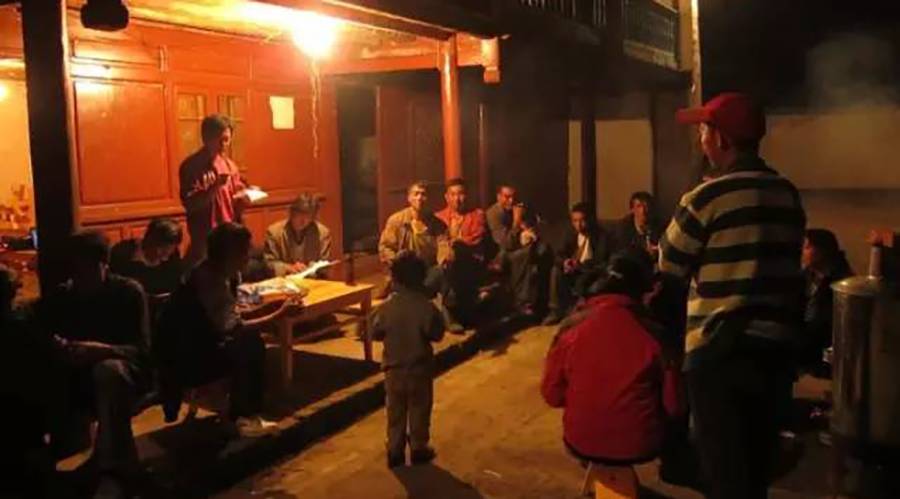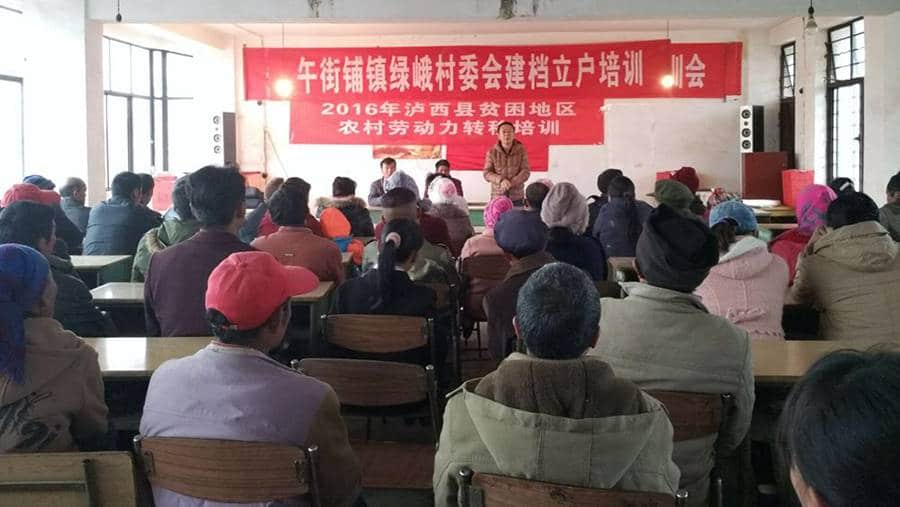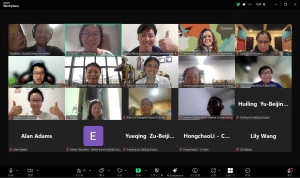Editor’s note
This article was written by 荀丽丽 (Xun Lili), an associate research fellow in the Sociology Research Institute of the Chinese Academy of Social Sciences, and originally appeared in 南都观察. Below is CDB’s translation. The article has been abridged in a few points.
“Looking at the standards for poverty alleviation, we can see that the state’s logic and the rural logic do not match. The state’s logic requires that poverty be identified down to the individual, in a way that is clear and easy to control, for instance with the establishment of household information cards. The rural logic is not the same however, because in order to avoid conflict village cadres want to equalize benefits.
In the face of uncertainties such as climate change, natural disasters, energy and water crises, diseases and the systemic risks of market economy, how to create and rebuild social support networks and improve different groups’ adaptability and resilience become the key issues in poverty alleviation.”
After the concept of “targeted measures of poverty alleviation” was put forward in 2013, the issues of rural development and poverty again became a hot topic in social research. Some people raised new questions: has poverty ended? What is the “new poverty era”?
The current targeted measures approach has brought a sense of accomplishment but also a certain sense of doubt. On the one hand, China’s performance on poverty alleviation is world renowned; on the other hand, some might wonder how so many villages and people have been able to get out of poverty within such a short period of time, and if there will really be no poverty by 2020.
What are the fundamental problems of poverty alleviation in the new era?
First of all, the long-term existence of poverty definitely has an objective basis. Uncertainty and risks objectively exist for the family, community, nation and on the global scale, for instance there are climate change, natural disasters, energy and water crises, diseases and the systemic risks of the market economy, and all of these are important factors that cause poverty. Even in the United States, where modern agriculture is highly developed, owners of large farms in Colorado still worry about getting caught unprepared by calamities like drought, disease or market volatility.
So, what are the basic problems of poverty alleviation? I do not think the problem should be understood plainly as “income poverty”, or that simply raising incomes can solve the problem. A focus of sociological research is how to build and rebuild social support networks in the face of risks, and how to improve the adaptability and resilience of individual groups. This is also a key question for poverty alleviation.
Secondly economic growth, which has income growth as its core, is not able to cover all the challenges we face. We must also face up to the issue of ecologically, economically and socially sustainable development. For example, rural non-point source pollution has led to the deterioration of natural resources like soil and underground water, and therefore caused risks to plant production and food safety for the developing rural economy. This is also a large factor in the creation of poverty.
Addressing the “locality” blind spot in the “Who should we support? How to support them? Who will help?” questions.
The locality blindspot within targeted poverty alleviation has two faces. First of all, we have to understand the meaning of “locality” in this context. After that, we can understand the issue from the point of view of the core questions in poverty alleviation: “Who should we support? How to support them? Who will help?”.
The so-called “locality” consists, first of all, of a place’s geographic conditions and social customs. Any form of social intervention should recognize this basic background as much as the local practitioners do.
Secondly, in the locality one needs to fully understand the local people’s “local scope”, including how they solve matters, how they understand good and evil, public and private, success and failure, diligence and other concepts. Poverty alleviation cannot be imposed only by external forces, but rather should try to achieve communication with the outside, transformation and renewal through an understanding of the local scope in these impoverished villages.
Thirdly, in the locality one also needs to understand the local traditions of managing public affairs, and local customs of public participation. It is worth wondering whether poverty alleviation as a public affair can achieve self-governance for rural communities.

A village meeting in Heyuan Laojun Mountain Village, Lijiang, Yunnan Province. The villagers’ representatives and the village committee formed a review group to grade each proposed project. Sansheng (an assisting NGO), county officials and experts formed a discussion group, and while they did not participate in the voting, they had the right to ask questions.
Who should we help? Is the impoverished population difficult to frame?
First of all, the question of who we should help is actually the problem of targeted poverty alleviation. The locality blindspot here is precisely the difficulty in targeting the resources of poverty alleviation. It is very hard to match them with the genuinely impoverished demographic. The top-down “indicator control” and “indicator distributions” of the targeted poverty alleviation policy determine its systemic bias. Although the government has invested unprecedented human and financial resources in poverty alleviation, the resources are in fact still limited.
The current poverty alleviation data is not collected and summarized from the bottom-up, which means the resources are not distributed according to how many people in poverty are identified at the local level. That could lead to a situation in which the local government blindly expands the size of the (reported) poor population to get more resources.
Looking at the standards for poverty alleviation, we can see that the state’s logic and the rural logic do not match. The state’s logic requires that poverty be identified down to the individual, in a way that is clear and easy to control, for instance with the establishment of special files and cards for impoverished household. The rural logic is not the same however, because in order to avoid conflict village cadres want to equalize benefits. They can normally choose the share of benefits for each group within the village, and very often groups with a lot of poor within them will be unable to receive a larger proportion of the resources marked for poverty alleviation, while groups with less poor among them will continue to receive their share of such resources.
The rigidity of the household information cards has caused a headache for many village officials. For example, one village party secretary said that in the past people would take turns in receiving funds from the top. This year it goes to your family, and next year it goes to another. However, under the targeted poverty alleviation policy, the cards are fixed, which means centralized support and centralized alleviation. This entails a great controversy within the rural communities over who to include on the list of the impoverished.
How to help? How to truly empower the impoverished population?
Secondly, we need to think about the “locality” blindspot. First of all, the local government’s targeted poverty alleviation practices show the typical characteristics of a form of governance based upon “campaigns” and subjected to a pressurizing national system. Under a lot of pressure from the top to alleviate poverty, local officials consider poverty alleviation to be closely related with their performance evaluations and promotions, and it is a highly politicized task. In these conditions, poverty alleviation resources are likely to be invested in exemplary sites where targets can be met more easily. Therefore, some remote villages may be ignored.
Second of all, the abstractness of the poor within the poverty alleviation industry is also a problem. Local governments generally prefer quick and wide-ranging projects. In the project designs, the funds and authority are concentrated in the rural cooperatives and leading enterprises through “capitalization” channels. The poor seem to enjoy easy benefits from these projects, but in fact it is difficult for them to participate effectively both in the production and distribution phases. What we see more of is “mobilized participation” and “nominal participation”, while it is hard to raise the poor people’s self-development capabilities. Without an “empowerment” mechanism, it is difficult to achieve the sustainability of poverty alleviation projects.
Besides, in some remote areas, genuine technological innovation faces big challenges and difficulties. For example, in a Yunnan village, the local agricultural research institutions provided a technology for free-range mushroom cultivation which was very helpful for the poor people in this remote mountainous area to achieve low-cost development. But it was very hard to get the local government’s approval, because this kind of dispersed industry is impossible to control, the scale is too small and the political achievements aren’t great enough. Even though this project was based upon genuine local needs, it still faced limitations under the present system.
I conducted a poverty alleviation field investigation in the Xiji-Haiyuan-Guyuan region. It is undeniable that poverty alleviation has made outstanding achievements in this area, especially in infrastructure construction. In some remote villages, however, is still hard to see an effective mechanism of endogenous development, or an empowerment mechanism.
In addition, with the development of the “new-type urbanization”, some poor people have moved to the surroundings of industrial zones or “modern agricultural-industrial parks”, since their original land has been transferred. Seemingly, both employment opportunities and incomes increase accordingly, but the safety network in poor families is weakened, because the elderly who were making a living in traditional agriculture now turn into “unemployed”. Their livelihood then comes to depend on their children, and family conflicts are thus inevitable.
I know of a primary school in a mountainous area where only 12 students are enrolled, and 9 of these children are not living with their mothers. Following the process of urbanization and industrialization, the high divorce rate and broken homes in the countryside are also a cause of increasing poverty, and significantly affect the sustainability of poverty alleviation. Clearly, these problems cannot be addressed by higher incomes.
Furthermore, the children in poor families easily get ignored. There is a little girl whose family has received support from the local poverty alleviation project, and is considered to have overcome poverty in this year. But because of recurring abdominal pains, she cannot go to school like normal children, and her family is unable to treat her. In the eyes of the locals, since she is almost 12 years old after a few years she will be able to get married. In practice it will be hard for her to enjoy any further education.
By revealing these “locality” blindspots, we find that it is impossible to understand the problem of poverty and its reproduction by simply increasing incomes.
In January 2017, a training session on the establishment of information files and cards for poor households was held at Wujiepu Town in Luxi County, Yunnan Province. © ynlxkx.com
Who should provide help? Why can’t poverty alleviation rely solely on the government?
Thirdly, on the issue of “who should provide help”, the government’s dominance has always been the characteristic and advantage of China’s anti-poverty interventions when compared to the international community. However, it is apparent that having the government as the only dynamic subject in huge targeted measures of poverty alleviation also has its disadvantages.
For villages, the “poverty alleviation resources delivery system” is actually an external and hierarchical administrative structure, and its internal mobilization mechanism and the efficiency of its transfer both affect the results of poverty alleviation. We need to think deeply and explore extensively to answer the question of how to return to a vision of rural endogenous development and achieve the empowerment of villages based on the local needs. If multiple social forces get involved in poverty alleviation, the possibilities and spaces for development are huge. For instance, Prof. Li Xiaoyun is not only a sociologist but also an actor in anti-poverty programs, which is very meaningful.
To sum up, in the “new poverty” era poverty alleviation inevitably has to go beyond the government system, and has to involve more social forces. Meanwhile, breaking through the “locality” blindspot, poverty alleviation must be combined with a systematic design for a rural renaissance. The rural renaissance should not simply be seen from the perspective of an opposition between cities and the countryside, but from the new perspective of urban and rural integrated development. Poverty alleviation which intends to eliminate “locality” blindspots requires the participation of the government and multiple subjects within society, and more importantly, anti-poverty efforts should be brought into the scope of rural public governance, therefore stimulating the endogenous energy of rural communities.
When we carried out research in Inner Mongolia we learnt that the herdsmen often suffer from natural disasters, and even a severe drought can cause them to return to poverty. In the 1990s, the rapid development under the contract system helped all the families of herdsmen generate income, but at the same time it weakened the collective force and the ability to protect against risks. Thus, the herdsmen restored the “collective sheep” system — known as Tie Tang (铁羊). This system is used to provide support when poverty suddenly arises within the community. If any family suffers a natural disaster or serious illness, the Tie Yang is the source of community help. The Yi Tian (义田) system in traditional villages also has the same function.
At present, since the rural collective economy tends to be made up of empty shells, rural communities are severely lacking in their internal capability to face a crisis. In future development, rural areas should have their own autonomy and flexibility to adapt to risks. Researchers also need to think about the problem of how to reconstruct the mechanism and ability of rural areas to manage their public affairs.




